Examples of Analysis Hierarchies
This topic explains how analysis hierarchies for end item substitution or supersession are created.
In the rest of this topic, one simple example and four detailed examples of analysis hierarchies are provided.
Simple Example of Analysis Hierarchy
Consider an organization that contains these substitution or supersession chains:
- A < > B < > C < > D
- X < > Y < > Z < > Z1
- F1 < > F2 > F3 < > F4
For these substitution or supersession chains, you can create a Product dimension hierarchy for a catalog called North America that contains these categories (primes):
- Category D that contains A, B, C, D.
- Category Z1 that contains X, Y, Z, and Z1
- Category F2 that contains F1 and F2
- Category F4 that contains F3 and F4
Note that a category is created for F1 and F2 and another for F3 and F4 because F2 and F3 don't have a bidirectional relationship.
Also, note that each category takes its name from the right-most item in the substitution or supersession chain.
This figure depicts the North America catalog:
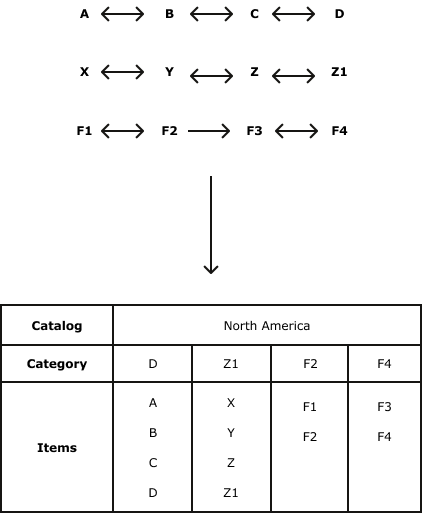
Detailed Example 1 of Analysis Hierarchy
In this detailed example, we have two regions. The locations in the regions mostly contain the same items. Therefore, we can create an analysis hierarchy for each region.
These are the locations and items with bidirectional relationships:
- M1 (for North America)
- A < > B < > C
- X < > Y < > Z
- F1 < > F2 < > F3 < > H4
- M2 (for North America)
- A < > B < > C < > D
- X < > Y < > Z < > Z1
- F1 < > F2 < > F3 < > H4
- M3 (for North America)
This location is selected for the analysis hierarchy.
- A < > B < > C < > D < > E
- X < > Y < > Z < > Z1 < > Z2
- F1 < > F2 < > F3 < > H4
- M4 (for North America)
- A < > B < > C < > D < > E
- X < > Y < > Z < > Z1 < > Z2
- F1 < > F2 < > F3 < > F4
- M5 (for North America)
- A < > B < > C < > D < > E
- X < > Y < > Z < > Z1 < > Z2
- F1 < > F2 < > F3 < > F4
- S1 (for the Europe, Middle East, and Africa (EMEA) region)
- A < > B < > C
- X < > Y < > Z
- F1 < > F2 < > F3 < > H5
- S2 (for the EMEA region)
- A < > B < > C < > D1
- X < > Y < > Z < > Z3
- F1< > F2 < > F3 < > H5
- S3 (for the EMEA region)
- A < > B < > C < > D1 < > E1
- X < > Y < > Z < > Z3 < > Z4
- F1< > F2 < > F3 < > H5
- S4 (for the EMEA region)
This location is selected for the analysis hierarchy.
- A < > B < > C < > D1 < > E1
- X < > Y < > Z < > Z3 < > Z4
- F1< > F2 < > F3 < > F5
- S5 (for the EMEA region)
- A < > B < > C < > D1 < > E1
- X < > Y < > Z < > Z3 < > Z4
- F1< > F2 < > F3 < > F5
This figure depicts the item relationships for this example:
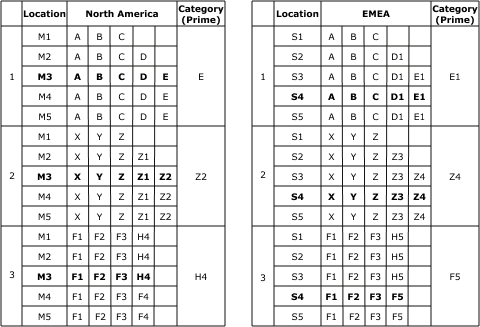
On the Manage Analysis Hierarchies for Related Items page, the created hierarchies (catalogs) and selected locations are as follows:
- North America, for location M3
- EMEA, for location S4
This figure depicts the created hierarchies and selected locations:

For these bidirectional item relationships and selections, these analysis hierarchies are created:
- North America (catalog), with categories E (for items A, B, C, D, and E), Z2 (for items X, Y, Z, Z1, and Z2), and H4 (for items F1, F2, F3, and H4)
- EMEA (catalog), with categories E1 (for items A, B, C, D1, and E1), Z4 (for items X, Y, Z, Z3, and Z4), and F5 (for items F1, F2, F3, and F5)
This figure depicts the analysis hierarchies for the example:

Note these points about the example:
- The organizations in North America and EMEA have different sets of items and therefore require separate analysis hierarchies. For example, M3 has items A, B, C, D, and E, while S3 has items A, B, C, D1, and E1.
- The E and Z2 categories are comprehensive enough for analysis of the substitution or supersession chains in M1, M2, M3, M4, and M5. However, the H4 category can cover analysis of only the substitution or supersession chains for M1, M2, and M3.
- The E1 and Z4 categories are comprehensive enough for analysis of the substitution or supersession chains in S1, S2, S3, S4, and S5. However, the F5 category can cover analysis of only the substitution or supersession chains for S4 and S5.
- For simplicity, the items have been listed in a sequence. However, the sequence isn't important in a substitution or supersession chain. For example, M1 could have had a substitution chain with items A, C, and E, and the substitution chain would still have been covered by the E category.
Detailed Example 2 of Analysis Hierarchy
In this detailed example, we have two regions. The locations in the regions contain multiple substitution or supersession chains, and selecting one location in each region with a representative analysis hierarchy is difficult. Therefore, we can create two analysis hierarchies for each region to cater to all the available substitution or supersession chains.
These are the locations and items with bidirectional relationships:
- M1 (for North America)
- A < > B < > C
- X < > Y < > Z
- F1 < > F2 < > F3 < > H4
- M2 (for North America)
- A < > B < > C < > D
- X < > Y < > Z < > Z1
- F1 < > F2 < > F3 < > H4
- M3 (for North America)
This location is selected for the analysis hierarchy.
- A < > B < > C < > D < > E
- X < > Y < > Z < > Z1 < > Z2
- F1 < > F2 < > F3 < > H4
- M4 (for North America)
This location is selected for the analysis hierarchy.
- A < > B < > C < > D < > E
- X < > Y < > Z < > Z1 < > Z3
- F1 < > F2 < > F3 < > F4
- M5 (for North America)
- A < > B < > C < > D < > E
- X < > Y < > Z < > Z1 < > Z3
- F1 < > F2 < > F3 < > F4
- S1 (for the EMEA region)
- A < > B < > C
- X < > Y < > Z
- F1 < > F2 < > F3 < > H5
- S2 (for the EMEA region)
- A < > B < > C < > D1
- X < > Y < > Z < > Z3
- F1< > F2 < > F3 < > H5
- S3 (for the EMEA region)
This location is selected for the analysis hierarchy.
- A < > B < > C < > D1 < > E1
- X < > Y < > Z < > Z3 < > Z4
- F1< > F2 < > F3 < > H5
- S4 (for the EMEA region)
This location is selected for the analysis hierarchy.
- A < > B < > C < > D1 < > E1
- X < > Y < > Z < > Z3 < > Z5
- F1< > F2 < > F3 < > F5
- S5 (for the EMEA region)
- A < > B < > C < > D1 < > E1
- X < > Y < > Z < > Z3 < > Z5
- F1< > F2 < > F3 < > F5
This figure depicts the item relationships for this example:
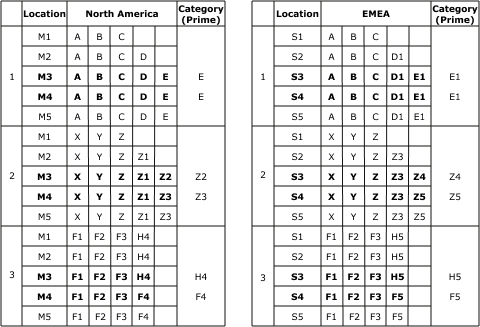
On the Manage Analysis Hierarchies for Related Items page, the created hierarchies (catalogs) and selected locations are as follows:
- North America - M3, for location M3
- North America - M4, for location M4
- EMEA - S3, for location S3
- EMEA - S4, for location S4
This figure depicts the created hierarchies and selected locations:

For these bidirectional item relationships and selections, these analysis hierarchies are created:
- North America - M3 (catalog), with categories E (for items A, B, C, D, and E), Z2 (for items X, Y, Z, Z1, and Z2), and H4 (for items F1, F2, F3, and H4)
- North America - M4 (catalog), with categories E (for items A, B, C, D, and E), Z3 (for items X, Y, Z, Z1, and Z3), and F4 (for items F1, F2, F3, and F4)
- EMEA - S3 (catalog), with categories E1 (for items A, B, C, D1, and E1), Z4 (for items X, Y, Z, Z3, and Z4), and H5 (for items F1, F2, F3, and H5)
- EMEA - S4 (catalog), with categories E1 (for items A, B, C, D1, and E1), Z5 (for items X, Y, Z, Z3, and Z5), and F5 (for items F1, F2, F3, and F5)
This figure depicts the analysis hierarchies for the example:
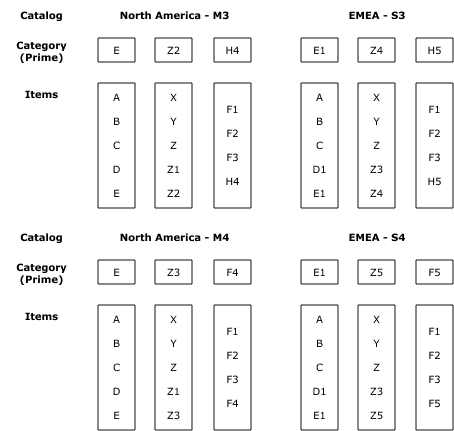
Note these points about the example:
- The organizations in North America and EMEA have different sets of items and therefore require separate analysis hierarchies. For example, M3 has items A, B, C, D, and E, while S3 has items A, B, C, D1, and E1.
- Within each region, there are subtle changes in the substitution or supersession chains. For example, M3 has items X, Y, Z, Z1, and Z2, while M4 has items X, Y, Z, Z1, and Z3.
- The E category is comprehensive enough for analysis of the substitution or supersession chains in M1, M2, M3, M4, and M5. However, the Z2 category can cover analysis of only the substitution or supersession chains for M1, M2, and M3, and the Z3 category can cover analysis of only the substitution or supersession chains for M1, M2, M4, and M5. Similarly, the H4 category can cover analysis of only the substitution or supersession chains for M1, M2, and M3, and the F4 category can cover analysis of only the substitution or supersession chains for M4 and M5.
- The E1 category is comprehensive enough for analysis of the substitution or supersession chains in S1, S2, S3, S4, and S5. However, the Z4 category can cover analysis of only the substitution or supersession chains for S1, S2, and S3, and the Z5 category can cover analysis of only the substitution or supersession chains for S1, S2, S4, and S5. Similarly, the H5 category can cover analysis of only the substitution or supersession chains in S1, S2, and S3, and the F5 category can cover analysis of only the substitution or supersession chains for S4 and S5.
- For simplicity, the items have been listed in a sequence. However, the sequence isn't important in a substitution or supersession chain. For example, M1 could have had a substitution chain with items A, C, and E, and the substitution chain would still have been covered by the E category.
Detailed Example 3 of Analysis Hierarchy
In this detailed example, we have two regions. The locations in the regions mostly contain the same items. Therefore, we can create an analysis hierarchy for both the regions. However, one substitution or supersession chain won't be covered by any analysis hierarchy, and duplicate categories won't be created.
These are the locations and items with bidirectional relationships:
- M1 (for North America)
- A < > B < > C
- X < > Y < > Z
- F1 < > F2 < > F3 < > H4
- M2 (for North America)
- A < > B < > C < > D
- X < > Y < > Z < > Z1
- F1 < > F2 < > F3 < > H4
- M3 (for North America)
This location is selected for the analysis hierarchy.
- A < > B < > C < > D < > E
- X < > Y < > Z < > Z1 < > Z2
- F1 < > F2 < > F3 < > H4
- M4 (for North America)
- A < > B < > C < > D < > E
- X < > Y < > Z < > Z1 < > Z2
- F1 < > F2 < > F3 < > F4
- M5 (for North America)
- A < > B < > C < > D < > E
- X < > Y < > Z < > Z1 < > Z2
- F1 < > F2 < > F3 < > H4
- S1 (for the EMEA region)
- A < > B < > C
- X < > Y < > Z
- P1 < > P2 < > P3 < > P4
- S2 (for the EMEA region)
- A < > B < > C < > D
- X < > Y < > Z < > Z1
- P1 < > P2 < > P3 < > P4
- S3 (for the EMEA region)
- A < > B < > C < > D < > E
- X < > Y < > Z < > Z1 < > Z2
- P1 < > P2 < > P3 < > P4
- S4 (for the EMEA region)
This location is selected for the analysis hierarchy.
- A < > B < > C < > D < > E
- X < > Y < > Z < > Z1 < > Z2
- P1 < > P2 < > P3 < > P4
- S5 (for the EMEA region)
- A < > B < > C < > D < > E
- X < > Y < > Z < > Z1 < > Z2
- P1 < > P2 < > P3 < > P4
This figure depicts the item relationships for this example:
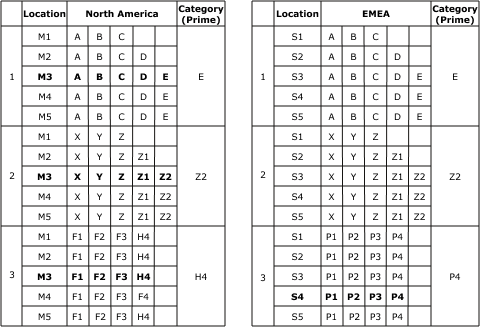
On the Manage Analysis Hierarchies for Related Items page, the created hierarchy (catalog) is North America and EMEA for the M3 and S4 locations.
This figure depicts the created hierarchy and selected locations:

For these bidirectional item relationships and selections, the North America and EMEA analysis hierarchy (catalog) is created, with categories E (for items A, B, C, D, and E), Z2 (for items X, Y, Z, Z1, and Z2), H4 (for items F1, F2, F3, and H4), and P4 (for items P1, P2, P3, and P4).
This figure depicts the analysis hierarchies for the example:

Note these points about the example:
- The organizations in North America and EMEA have the same substitution or supersession chains and also different substitution or supersession chains. For example, M1, M2, M3, and M5 have items F1, F2, F3, and H4, while M4 has items F1, F2, F3, and F4. S1, S2, S3, S4, and S5 have items P1, P2, P3, and P4.
- The E, Z2, and P4 categories are comprehensive enough for analysis of the substitution or supersession chains in M1, M2, M3, M4, and M5, and S1, S2, S3, S4, and S5.
- The H4 category is comprehensive enough for analysis of the substitution or supersession chains in M1, M2, M3, and M5. However, the category can't cover analysis of the substitution or supersession chain for M4.
- Only one instance of the E category is created for organization M3. A duplicate of the category isn't created for organization S4.
- Only one instance of the Z2 category is created for organization M3. A duplicate of the category isn't created for organization S4.
- For simplicity, the items have been listed in a sequence. However, the sequence isn't important in a substitution or supersession chain. For example, M1 could have had a substitution chain with items A, C, and E, and the substitution chain would still have been covered by the E category.
Detailed Example 4 of Analysis Hierarchy
In this detailed example, we have two regions. The locations in the regions contain similar and different items. Therefore, we can create two analysis hierarchies for each region. However, one substitution or supersession chain in each region won't be covered by an analysis hierarchy, and duplicate categories won't be created.
These are the locations and items with bidirectional relationships:
- M1 (for North America)
- A < > B < > C
- X < > Y < > Z
- F1 < > F2 < > F3 < > H4
- M2 (for North America)
- A < > B < > C < > D
- X < > Y < > Z < > Z1
- F1 < > F2 < > F3 < > H4
- M3 (for North America)
This location is selected for the analysis hierarchy.
- A < > B < > C < > D < > E
- X < > Y < > Z < > Z1 < > Z2
- F1 < > F2 < > F3 < > H4
- M4 (for North America)
This location is selected for the analysis hierarchy.
- A < > B < > C < > D < > E
- X < > Y < > Z < > Z1 < > Z2
- F1 < > F2 < > F3 < > F4
- Q1 < > Q2 < > Q3 < > Q4
- M5 (for North America)
- A < > B < > C < > D < > E
- X < > Y < > Z < > Z1 < > Z2
- F1 < > F2 < > F3 < > F4
- S1 (for the EMEA region)
- A < > B < > C
- X < > Y < > Z
- F1 < > F2 < > F3 < > H5
- S2 (for the EMEA region)
- A < > B < > C < > D1
- X < > Y < > Z < > Z3
- F1< > F2 < > F3 < > H5
- S3 (for the EMEA region)
This location is selected for the analysis hierarchy.
- A < > B < > C < > D1 < > E1
- X < > Y < > Z < > Z3 < > Z4
- F1< > F2 < > F3 < > H5
- S4 (for the EMEA region)
This location is selected for the analysis hierarchy.
- A < > B < > C < > D1 < > E1
- X < > Y < > Z < > Z3 < > Z4
- F1< > F2 < > F3 < > F5
- J1 < > J2 < > J3 < > J4
- S5 (for the EMEA region)
- A < > B < > C < > D1 < > E1
- X < > Y < > Z < > Z3 < > Z4
- F1< > F2 < > F3 < > F5
This figure depicts the item relationships for this example:
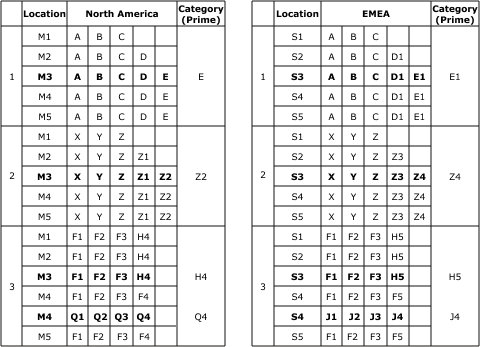
On the Manage Analysis Hierarchies for Related Items page, the created hierarchies (catalogs) and selected locations are as follows:
- North America - M3 and M4, for locations M3 and M4
- EMEA - S3 and S4, for locations S3 and S4
This figure depicts the created hierarchies and selected locations:

For these bidirectional item relationships and selections, these analysis hierarchies are created:
- North America - M3 and M4 (catalog), with categories E (for items A, B, C, D, and E), Z2 (for items X, Y, Z, Z1, and Z2), H4 (for items F1, F2, F3, and H4), and Q4 (for items Q1, Q2, Q3, and Q4)
- EMEA - S3 and S4 (catalog), with categories E1 (for items A, B, C, D1, and E1), Z4 (for items X, Y, Z, Z3, and Z4), H5 (for items F1, F2, F3, and H5), and J4 (for items J1, J2, J3, and J4)
This figure depicts the analysis hierarchies for the example:

Note these points about the example:
- The organizations in North America and EMEA have different sets of items and therefore require separate analysis hierarchies. For example, M4 has items Q1, Q2, Q3, and Q4, while S4 has items J1, J2, J3, and J4.
- The E and Z2 categories are comprehensive enough for analysis of the substitution or supersession chains in M1, M2, M3, M4, and M5. However, the H4 category can cover analysis of only the substitution or supersession chains for M1, M2, and M3, while the Q4 category can cover analysis of only the substitution or supersession chain for M4.
- The E1 and Z4 categories are comprehensive enough for analysis of the substitution or supersession chains in S1, S2, S3, S4, and S5. However, the H5 category can cover analysis of only the substitution or supersession chains for S1, S2, and S3, while the J4 category can cover analysis of only the substitution or supersession chain for S4.
- For every organization, categories are created for only unique substitution or
supersession chains. A category named F4 isn't created for organization M4
because the category would be similar to the H4 category for organization M3.
Similarly, a category named F5 isn't created for organization S4 because the
category would be similar to the H5 category for organization S3.
If categories are required for all variants of substitution or supersession chains, then separate catalogs should be created for organizations M3, M4, S3, and S4, as in the second detailed example.
- For simplicity, the items have been listed in a sequence. However, the sequence isn't important in a substitution or supersession chain. For example, M1 could have had a substitution chain with items A, C, and E, and the substitution chain would still have been covered by the E category.